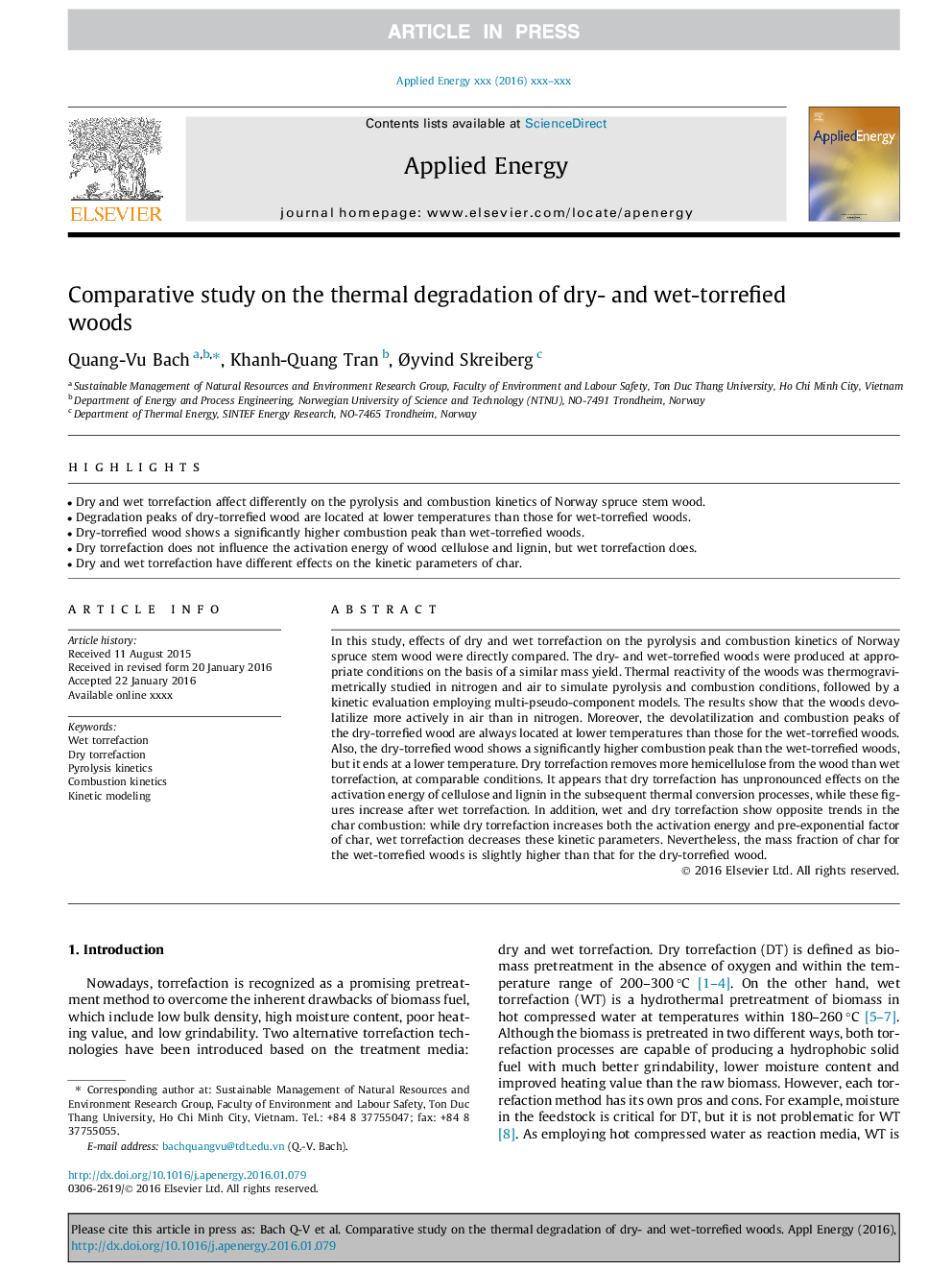| کد مقاله | کد نشریه | سال انتشار | مقاله انگلیسی | نسخه تمام متن |
|---|---|---|---|---|
| 4917041 | 1362739 | 2017 | 8 صفحه PDF | دانلود رایگان |
عنوان انگلیسی مقاله ISI
Comparative study on the thermal degradation of dry- and wet-torrefied woods
ترجمه فارسی عنوان
مطالعه مقایسه ای در مورد تخریب حرارتی جنگل های خشک و مرطوب
دانلود مقاله + سفارش ترجمه
دانلود مقاله ISI انگلیسی
رایگان برای ایرانیان
کلمات کلیدی
ترجمه چکیده
در این تحقیق، اثرات ترک خوردگی خشک و مرطوب بر کینتیک های پیلوریزاسیون و احتراق چوب ساحلی درختان نر به طور مستقیم مقایسه شد. جنگل خشک و مرطوب در شرایط مناسب بر اساس یک عملکرد توده مشابه تولید می شود. واکنش پذیری حرارتی جنگل ها به وسیله ترموگرافیمتری در نیتروژن و هوا مورد مطالعه قرار گرفت تا شبیه سازی شرایط پیلوریس و احتراق، و سپس ارزیابی جنبشی با استفاده از مدل های چند پویا. نتایج نشان می دهد که جنگل ها به طور فعال در هوا نسبت به نیتروژن فعال تر است. علاوه بر این، قله های پراکندگی و احتراق چوب خشک شده همیشه در درجه حرارت پایین تر از آنهایی است که برای جنگل های ریز ریز مرطوب قرار دارند. همچنین چوب چوب خرد شده دارای بالاترین میزان احتراق بالاتر از جنگل های مرطوب است، اما به دمای پایین پایان می یابد. فرسایش خشک باعث حذف همسیلولز بیشتر از چوب از ترشحات مرطوب، در شرایط قابل مقایسه است. به نظر می رسد که فرسایش خام بر روی انرژی فعال سازی سلولز و لیگنین در فرآیند تبدیل حرارتی پس از آن تأثیری نداشته است، در حالی که این ارقام بعد از خنثی شدن خیس افزایش می یابد. علاوه بر این، فرسایش خیس و مرطوب نشانگر روند مخالف در احتراق کاراکتر است: در حالی که فرسایش خام افزایش انرژی فعال و پیش پارامتر کاراکتر، خسارت مرطوب، این پارامترهای سینتیکی را کاهش می دهد. با این وجود، مقدار جرمی از چوب برای جنگل های مرطوب شده کمی بالاتر از چوب چوب خشک است.
موضوعات مرتبط
مهندسی و علوم پایه
مهندسی انرژی
مهندسی انرژی و فناوری های برق
چکیده انگلیسی
In this study, effects of dry and wet torrefaction on the pyrolysis and combustion kinetics of Norway spruce stem wood were directly compared. The dry- and wet-torrefied woods were produced at appropriate conditions on the basis of a similar mass yield. Thermal reactivity of the woods was thermogravimetrically studied in nitrogen and air to simulate pyrolysis and combustion conditions, followed by a kinetic evaluation employing multi-pseudo-component models. The results show that the woods devolatilize more actively in air than in nitrogen. Moreover, the devolatilization and combustion peaks of the dry-torrefied wood are always located at lower temperatures than those for the wet-torrefied woods. Also, the dry-torrefied wood shows a significantly higher combustion peak than the wet-torrefied woods, but it ends at a lower temperature. Dry torrefaction removes more hemicellulose from the wood than wet torrefaction, at comparable conditions. It appears that dry torrefaction has unpronounced effects on the activation energy of cellulose and lignin in the subsequent thermal conversion processes, while these figures increase after wet torrefaction. In addition, wet and dry torrefaction show opposite trends in the char combustion: while dry torrefaction increases both the activation energy and pre-exponential factor of char, wet torrefaction decreases these kinetic parameters. Nevertheless, the mass fraction of char for the wet-torrefied woods is slightly higher than that for the dry-torrefied wood.
ناشر
Database: Elsevier - ScienceDirect (ساینس دایرکت)
Journal: Applied Energy - Volume 185, Part 2, 1 January 2017, Pages 1051-1058
Journal: Applied Energy - Volume 185, Part 2, 1 January 2017, Pages 1051-1058
نویسندگان
Quang-Vu Bach, Khanh-Quang Tran, Ãyvind Skreiberg,
